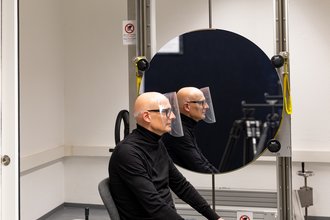
»BauhausUniVisor« tested in front of the Schlieren mirror
The »BauhausUniVisor« has been produced in the Bauhaus Form + Function Lab (BFFL) since April and is now being used in various places. Thanks to the interdisciplinary cooperation between academic staff for product design and building physics at the Bauhaus-Universität Weimar, a video now shows how wearing the visor affects the spread of the air we breathe.
Amayu Wakoya Gena (MSc) and Professor Conrad Völker from the Professorship for Building Physics were already using the Schlieren mirror in March to show how the air we breathe is spread when we cough with and without covering our mouth and nose. The visualisation attracted a great deal of media interest, particularly in light of the social distancing measures and obligation to wear a face mask due to the coronavirus pandemic. The experiment in the Schlieren laboratory has now been repeated to test the effectiveness of the newly developed »BauhausUniVisor«.
Professor Andreas Mühlenberend – who developed the visor together with Assistant Professor Jason Reizner and Kristian Gohlke – was himself the test subject, standing before the test set-up with a Schlieren mirror and high-resolution camera for the experiment. Different scenarios were tested, namely breathing, coughing and speaking. The air breathed was visualised without his mouth and nose being covered, then again while wearing the visor. The outcome: no exhalation clouds are visible outside the visor directly in front of the wearer, as the air breathed is diverted downwards and upwards by the protective film in front of their face. In contrast, without the protective visor, the air breathed spreads at different speeds and far out in front of them.
It is important to note that the turbulence below Professor Mühlenberend’s head and the air rising above it due to body heat (natural convection) occurs independently of the air we breathe and is also visible in front of the Schlieren mirror. The Schlieren mirror test does not provide any information on distribution of the liquid particles known as aerosols suspended in the air.
Despite the visor’s effect, which can be seen in the video, the experiment’s participants emphasise that it is still important to adhere to social distancing and all instructions issued by the health authorities and particularly to maintain an appropriate distance if you are experiencing symptoms.

Gesichtsvisier im Schlierenspiegel-Test
Click the Play button to load and view external content from Vimeo.com.
Automatically load and view external content from Vimeo.com (You can change this setting at any time via our »Data protection policy«.)
About the Schlieren method
The Schlieren method is a technique for visualising and measuring indoor airflow. Fluctuations in the optical refractive index of air are visualised, which allows thermal convection currents to be seen, for example. The set-up essentially comprises a mirror with the precision of an astronomical telescope, a light source and a high-resolution camera.
About the »BauhausUniVisor«
The »BauhausUniVisor« that was tested has ergonomic advantages over a mask: breathing is not restricted (this is particularly important for individuals with pre-existing medical conditions), facial expressions are still visible (and social interaction thus preserved), wearers do not need to touch their faces to correct any slippage, glasses do not fog, and there is no increase in sweating (and consequently also no moisture formation on the skin or in the mouth area). These advantages should boost make it easier for people to adopt hygiene precautions in daily life.
Contact
Prof. Andreas Mühlenberend (BauhausUniVisor)
Bauhaus-Universität Weimar
Faculty of Art and Design / Professorship for Product Design – Industrial Design
Tel.: +49(0)36 43 58 3387
E-mail: andreas.muehlenberend@uni-weimar.de
Prof. Dr.-Ing. Conrad Völker (Schlieren mirror)
Bauhaus-Universität Weimar
Faculty of Civil Engineering
Professorship for Building Physics
Tel.: +49 (0) 36 43 / 58 47 01
E-mail: conrad.voelker@uni-weimar.de
